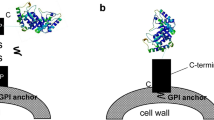Abstract
By cell surface display of ModE protein that is a transcriptional regulator of operons involved in the molybdenum metabolism in Escherichia coli, we have constructed a molybdate-binding yeast (Nishitani et al., Appl Microbiol Biotechnol 86:641–648, 2010). In this study, the binding specificity of the molybdate-binding domain of the ModE protein displayed on yeast cell surface was improved by substituting the amino acids involved in oxyanion binding with other amino acids. Although the displayed S126T, R128E, and T163S mutant proteins adsorbed neither molybdate nor tungstate, the displayed ModE mutant protein (T163Y) abolished only molybdate adsorption, exhibiting the specific adsorption of tungstate. The specificity of the displayed ModE mutant protein (T163Y) for tungstate was increased by approximately 9.31-fold compared to the displayed wild-type ModE protein at pH 5.4. Therefore, the strategy of protein design and its cell surface display is effective for the molecular breeding of bioadsorbents with metal-specific adsorption ability based on a single species of microorganism without isolation from nature.





Similar content being viewed by others
References
DeLano WL (2002) The PyMOL molecular graphics system. DeLano Scientific, San Carlos
Gourley DG, Schuttelkopf AW, Anderson LA, Price NC, Boxer DH, Hunter WN (2001) Oxyanion binding alters conformation and quaternary structure of the C-terminal domain of the transcriptional regulator mode. Implications for molybdate-dependent regulation, signaling, storage, and transport. J Biol Chem 276:20641–20647
Hollenstein K, Frei DC, Locher KP (2007) Structure of an ABC transporter in complex with its binding protein. Nature 446:213–216
Hou YM, Kim R, Kim SH (1988) Expression of the mouse metallothionein-I gene in Escherichia coli: increased tolerance to heavy metals. Biochim Biophys Acta 951:230–234
Ito H, Fukuda Y, Murata K, Kimura A (1983) Transformation of intact yeast cells treated with alkali cations. J Bacteriol 153:163–168
Kisker C, Schindelin H, Rees DC (1997) Molybdenum-cofactor-containing enzymes: structure and mechanism. Annu Rev Biochem 66:233–267
Kuper J, Meyer zu Berstenhorst S, Vodisch B, Mendel RR, Schwarz G, Boxer DH (2003) In vivo detection of molybdate-binding proteins using a competition assay with ModE in Escherichia coli. FEMS Microbiol Lett 218:187–193
Kuroda K, Ueda M (2010) Engineering of microorganisms towards recovery of rare metal ions. Appl Microbiol Biotechnol 87:53–60
Kuroda K, Ueda M (2011a) Cell surface engineering of yeast for applications in white biotechnology. Biotechnol Lett 33:1–9
Kuroda K, Ueda M (2011b) Molecular design of the microbial cell surface toward the recovery of metal ions. Curr Opin Biotechnol 22:427–433
Kuroda K, Shibasaki S, Ueda M, Tanaka A (2001) Cell surface-engineered yeast displaying a histidine oligopeptide (hexa-His) has enhanced adsorption of and tolerance to heavy metal ions. Appl Microbiol Biotechnol 57:697–701
Kuroda K, Matsui K, Higuchi S, Kotaka A, Sahara H, Hata Y, Ueda M (2009) Enhancement of display efficiency in yeast display system by vector engineering and gene disruption. Appl Microbiol Biotechnol 82:713–719
Ledin M (2000) Accumulation of metals by microorganisms — processes and importance for soil systems. Earth Sci Rev 51:1–31
Lee SY, Choi JH, Xu Z (2003) Microbial cell-surface display. Trends Biotechnol 21:45–52
McNicholas PM, Mazzotta MM, Rech SA, Gunsalus RP (1998) Functional dissection of the molybdate-responsive transcription regulator, ModE, from Escherichia coli. J Bacteriol 180:4638–4643
Murzin AG (1993) OB(oligonucleotide/oligosaccharide binding)-fold: common structural and functional solution for non-homologous sequences. EMBO J 12:861–867
Nishitani T, Shimada M, Kuroda K, Ueda M (2010) Molecular design of yeast cell surface for adsorption and recovery of molybdenum, one of rare metals. Appl Microbiol Biotechnol 86:641–648
Samuelson P, Gunneriusson E, Nygren PA, Stahl S (2002) Display of proteins on bacteria. J Biotechnol 96:129–154
Sayers Z, Brouillon P, Vorgias CE, Nolting HF, Hermes C, Koch MH (1993) Cloning and expression of Saccharomyces cerevisiae copper-metallothionein gene in Escherichia coli and characterization of the recombinant protein. Eur J Biochem 212:521–528
Ueda M, Tanaka A (2000a) Cell surface engineering of yeast: construction of arming yeast with biocatalyst. J Biosci Bioeng 90:125–136
Ueda M, Tanaka A (2000b) Genetic immobilization of proteins on the yeast cell surface. Biotechnol Adv 18:121–140
Vijayaraghavan K, Jegan J, Palanivelu K, Velan M (2004) Removal of nickel(II) ions from aqueous solution using crab shell particles in a packed bed up-flow column. J Hazard Mater 113:223–230
Volesky B, Weber J, Park JM (2003) Continuous-flow metal biosorption in a regenerable Sargassum column. Water Res 37:297–306
Wagner UG, Stupperich E, Kratky C (2000) Structure of the molybdate/tungstate binding protein mop from Sporomusa ovata. Structure 8:1127–1136
Author information
Authors and Affiliations
Corresponding author
Rights and permissions
About this article
Cite this article
Kuroda, K., Nishitani, T. & Ueda, M. Specific adsorption of tungstate by cell surface display of the newly designed ModE mutant. Appl Microbiol Biotechnol 96, 153–159 (2012). https://doi.org/10.1007/s00253-012-4069-1
Received:
Revised:
Accepted:
Published:
Issue Date:
DOI: https://doi.org/10.1007/s00253-012-4069-1




